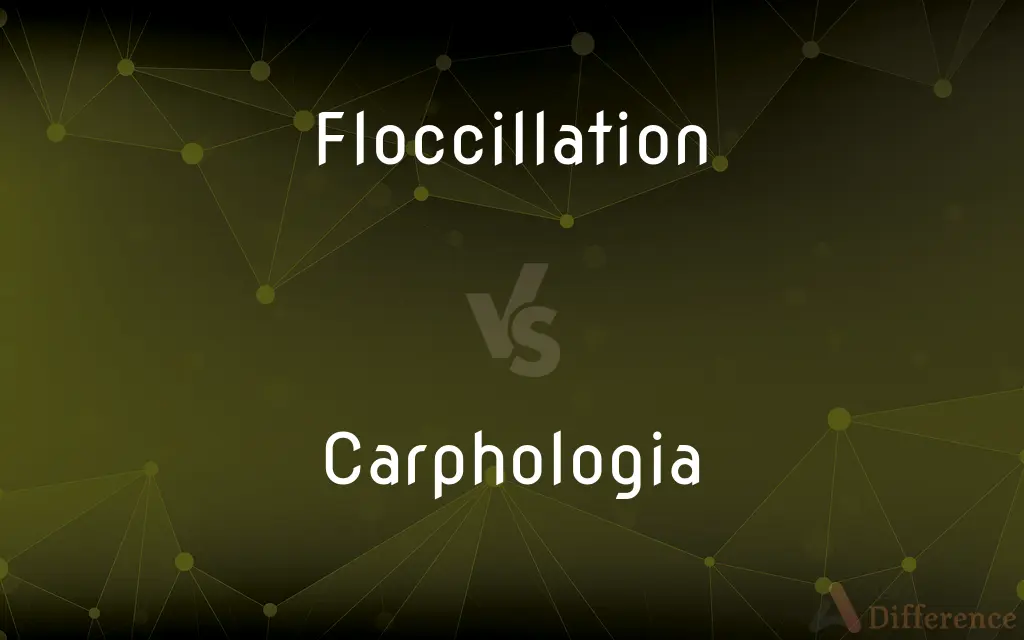Floccillation vs. Carphologia — What's the Difference?
By Maham Liaqat & Urooj Arif — Updated on April 7, 2024
Floccillation involves picking at bedclothes as a hallucinatory activity, often seen in delirious patients, whereas carphologia is the picking at imaginary objects, seen in feverish delirium.

Difference Between Floccillation and Carphologia
Table of Contents
ADVERTISEMENT
Key Differences
Floccillation is a specific type of restlessness observed in patients, where they repeatedly pick at bed linens or clothing, often due to hallucinations or delusions. This behavior is commonly associated with severe illnesses or delirium, especially in the terminal stages of diseases. Carphologia, on the other hand, involves similar picking movements but is directed towards imaginary objects or particles that the patient believes to see or feel, typically occurring in feverish states or delirium caused by infections or high fevers.
Patients exhibiting floccillation are often trying to grasp or manipulate their immediate physical environment, possibly as a response to discomfort, anxiety, or neurological impairment. This action suggests a level of disconnection from reality but still an interaction with the physical world. Whereas, carphologia indicates a deeper level of hallucination where the patient reaches for or tries to pick up objects that are not actually present, pointing to a more profound alteration in perception and cognitive function.
In terms of clinical significance, floccillation can be an important indicator for healthcare providers of a patient's deteriorating condition or the progression towards the end of life. It signals the need for comprehensive care strategies, including comfort measures and potentially the evaluation of palliative care options. Carphologia, while also signaling serious health concerns, specifically suggests the presence of fever-induced delirium and may prompt investigations into underlying infections or metabolic imbalances.
Management strategies for patients showing signs of floccillation often include environmental modifications to reduce stimuli and interventions to address the underlying cause of the delirium. Comfort care, ensuring the patient’s safety, and addressing any reversible causes are priorities. In contrast, managing carphologia might focus more on treating the underlying infection or fever, alongside symptomatic care to ensure patient comfort and safety, including the use of antipyretics or antibiotics as appropriate.
Both floccillation and carphologia are symptoms that require careful assessment and management, as they can indicate severe underlying conditions. While the former is more associated with the physical interaction with real objects, albeit in a disoriented manner, the latter involves interaction with imaginary objects, reflecting a deeper level of cognitive impairment. Recognizing these behaviors as part of a broader clinical picture is crucial for providing appropriate care and support to patients experiencing these distressing symptoms.
ADVERTISEMENT
Comparison Chart
Definition
Picking at bedclothes due to hallucinations or delirium
Picking at imaginary objects due to feverish delirium
Associated Conditions
Often seen in terminal stages of diseases
Commonly occurs in fever-induced delirium
Perception
Interaction with physical objects
Interaction with non-existent objects
Clinical Significance
Indicator of deteriorating condition or end of life
Suggests fever-induced delirium, possibly infection
Management Focus
Comfort care, environmental modification
Treatment of underlying cause, symptomatic care
Compare with Definitions
Floccillation
Restless picking at bedclothes by a delirious patient.
The patient's floccillation was distressing to family members, signaling his discomfort.
Carphologia
Seen in delirious states.
Carphologia is a distressing symptom of delirium in feverish patients.
Floccillation
A manifestation of neurological impairment.
Floccillation in the patient indicated severe cognitive disruption.
Carphologia
Picking at unseen objects by feverish patients.
Carphologia often indicates severe fever or infection.
Floccillation
Observed in serious illnesses.
Her floccillation was a sign of the illness's progression.
Carphologia
Signals need for immediate care.
Her carphologia prompted a review of her treatment to manage fever.
Floccillation
Sign of patient's disconnection from reality.
Floccillation showed his disconnection from the surrounding reality.
Carphologia
Reflects profound cognitive impairment.
Carphologia in patients can signify severe cognitive disturbances.
Floccillation
Requires careful management.
Managing floccillation involved creating a calm environment for the patient.
Carphologia
Indicates deep level of hallucination.
The patient's carphologia suggested he was experiencing vivid hallucinations.
Floccillation
(rare) Picking at the bedclothes, usually seen in delirious, feverish or dying people.
Carphologia
Picking at bedding and clothing, or at the lips, or of perceived invisible objects
Floccillation
A delirious picking of bedclothes by a sick person, as if to pick off flocks of wool; carphology; - an alarming symptom in acute diseases.
Carphologia
Carphologia (or carphology) is a lint-picking behavior that is often a symptom of a delirious state. Often seen in delirious or semiconscious patients, carphologia describes the actions of picking or grasping at imaginary objects, as well as the patient's own clothes or bed linens.
Common Curiosities
What is carphologia?
Carphologia involves the delirious picking at or trying to grasp imaginary objects, usually seen in patients with fever-induced delirium.
What causes floccillation?
Floccillation can be caused by delirium, severe illness, or neurological impairment, often in the terminal stages of diseases.
What indicates the presence of carphologia?
Carphologia is indicated by the patient's attempts to pick up non-existent objects, suggesting hallucinations or severe delirium.
Can floccillation and carphologia occur simultaneously?
Yes, both symptoms can be present in the same patient, especially in severe delirium or in the terminal phases of illnesses.
Are floccillation and carphologia exclusive to specific diseases?
No, these symptoms are not exclusive to specific diseases but are indicators of severe illness, delirium, or neurological impairment.
How do these symptoms affect the patient's quality of life?
These symptoms can significantly impact the patient's quality of life, causing distress, discomfort, and a sense of disconnection from reality.
How is floccillation managed in clinical settings?
Management includes addressing underlying causes, providing comfort care, and modifying the environment to reduce stimuli and distress.
Do floccillation and carphologia have different prognostic implications?
Both symptoms are indicative of serious health concerns, but their prognostic implications depend on the underlying conditions and overall patient health.
Is there a psychological aspect to floccillation and carphologia?
Yes, both symptoms can be associated with psychological distress, hallucinations, and cognitive impairment.
Are there any long-term effects of floccillation and carphologia?
The long-term effects depend on the resolution of the underlying conditions; however, these symptoms themselves are indicative of acute distress or illness phases.
What is floccillation?
Floccillation refers to the restless and repetitive act of picking at bedclothes or garments, often observed in delirious or severely ill patients.
How do healthcare providers treat carphologia?
Treatment focuses on the underlying fever or infection causing the delirium and symptomatic care to ensure patient comfort and safety.
Can floccillation and carphologia be prevented?
Prevention focuses on treating the underlying conditions and minimizing factors that could exacerbate delirium or cognitive impairment.
What role do caregivers play in managing these symptoms?
Caregivers play a crucial role in providing comfort, ensuring patient safety, and supporting the clinical management of these symptoms.
How do family members perceive these symptoms?
Family members may find these symptoms distressing, as they signal the patient's discomfort and possible deterioration of health.
Share Your Discovery

Next Comparison
Super vs. SupperAuthor Spotlight
Written by
Maham LiaqatCo-written by
Urooj ArifUrooj is a skilled content writer at Ask Difference, known for her exceptional ability to simplify complex topics into engaging and informative content. With a passion for research and a flair for clear, concise writing, she consistently delivers articles that resonate with our diverse audience.
















































